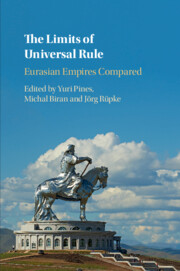Book contents
- The Limits of Universal Rule
- The Limits of Universal Rule
- Copyright page
- Contents
- Maps
- Figures
- Contributors
- Abbreviations
- Preface
- Introduction
- 1 From the Mediterranean to the Indus Valley: Modalities and Limitations of the Achaemenid Imperial Space
- 2 Limits of All-Under-Heaven: Ideology and Praxis of “Great Unity” in Early Chinese Empire
- 3 The Roman Empire
- 4 The Medieval Roman Empire of the East as a Spatial Phenomenon (300–1204 CE)
- 5 Early Islamic Imperial Space
- 6 The Mongol Imperial Space
- 7 The Territories and Boundaries of Empires
- 8 Delimiting the Realm Under the Ming Dynasty
- 9 The Expansion of the Qing Empire Before 1800
- 10 All Under the Tsar
- Index
- References
4 - The Medieval Roman Empire of the East as a Spatial Phenomenon (300–1204 CE)
Published online by Cambridge University Press: 07 January 2021
- The Limits of Universal Rule
- The Limits of Universal Rule
- Copyright page
- Contents
- Maps
- Figures
- Contributors
- Abbreviations
- Preface
- Introduction
- 1 From the Mediterranean to the Indus Valley: Modalities and Limitations of the Achaemenid Imperial Space
- 2 Limits of All-Under-Heaven: Ideology and Praxis of “Great Unity” in Early Chinese Empire
- 3 The Roman Empire
- 4 The Medieval Roman Empire of the East as a Spatial Phenomenon (300–1204 CE)
- 5 Early Islamic Imperial Space
- 6 The Mongol Imperial Space
- 7 The Territories and Boundaries of Empires
- 8 Delimiting the Realm Under the Ming Dynasty
- 9 The Expansion of the Qing Empire Before 1800
- 10 All Under the Tsar
- Index
- References
Summary
This chapter discusses some general principles of spatial organisation and perception in the Medieval Roman (“Byzantine”) Empire as can be reconstructed from written sources, furthermore the definition and dynamics of frontiers and the significance of the centre (Constantinople) and its demands for the spatial framework of imperial politics. The chronological focus is on the centuries from the inauguration of Constantinople as new capital (330 CE) up to the Fourth Crusade in 1204 CE. Furthermore, the papers deal more with the frontiers and relations of Byzantium to the East, where also Byzantine authors identified (competing) polities of a similar imperial quality, than with the connections to and conflicts with medieval Western Europe. It aims to demonstrate how specific aspects of Byzantium´s spatial dynamics can be integrated in a more general comparative discussion of empires as spatial phenomena.
Keywords
- Type
- Chapter
- Information
- The Limits of Universal RuleEurasian Empires Compared, pp. 141 - 179Publisher: Cambridge University PressPrint publication year: 2021

